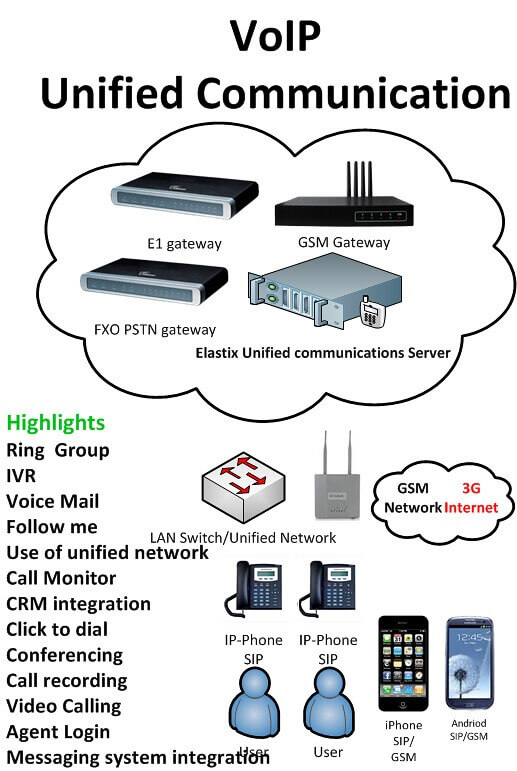
If you are contemplating a VoIP telephone system for your company or agency, then you are probably already aware of the advantages that VoIP telephone system can provide you.
A VoIP PBX saves you time, has flexible modern functionality, allows your employees to work remotely, is extremely user-friendly, and can be scaled easily as your company expands or downsizes. However, to get the most out of a VoIP system, you need to have great internet speed and bandwidth. The relationship between the quality of your internet and VoIP quality is undeniable.
A Brief History of the Internet
The internet has transformed the world of computing and communications like never before. Radio, telegraph, telephone, and compute innovation is what has paved the way for this unparalleled convergence of capabilities.
The Internet is, therefore, a global broadcasting tool, a platform for the sharing of information and a means for communication and interaction between people and their devices, irrespective of their geographical location
It all began in 1962 when J.C.R. Licklider—the ARPA (Advanced Research Projects Agency) IPTO’s director at the time—published an explanation of social interactions that could be facilitated via networking. It was the first time someone envisaged a globally interconnected network of computers which would enable anyone to get easy and quick access to data and applications from any website. The rest as they say is history.
The 70s saw the first code for network email being a writer and the funding of three TCP/IP protocol implementations. In the early 80s, we witnessed the publishing of two major documents in the history of the internet—ENQUIRE and RFC 82. The latter was the first document describing the Domain Name System (DNS) while ENQUIRE documented the connection between projects, computers, and people.
In 1985, symbolics.com—the first internet domain name—was registered, and in 1987, Apple released a Hypertext application. However, it was the 90s when the real internet revolution took place. It started with the development of the first internet engine called Archie in 1990, followed by the development of the first website in the same year. In 1991, the first website developed in the U.S went live. In 1993, the web protocol and code was made free to all users and 1994 the Worldwide Web Consortium was established. This opened the door for so many internet-based innovations that we have today.
When Did VoIP Enter the Picture?
The transmission of VoIP began as early as 1973. However, it took another 22 years for the first internet-based telephone system to make its appearance. The original purpose of VoIP was to reduce the cost of making international and long-distance calls.
The company that introduced VoIP to the world and improved it to its current state is VocalTec. Initially, VocalTec’s VoIP that went by the same name required users to have the same software, a microphone, and a sound card to be able to work on their computers. However, improvements were made and Internet voicemail applications were added to the VoIP system. Additionally, the VoIP software was paired with Microsoft NetMeeting.
VocalTec then incorporated phone-to-phone and computer-to-telephone calling features. At this time, the adoption of VoIP was a mere 1%. However, as internet speeds increased and costs of VoIP systems lowered, the adoption rates started to grow. In 2017, the number of VoIP users worldwide was 1 billion and this number is expected to grow to 3 billion by 2021. So, what is VoIP exactly? We discuss that next.

Webopedia defines VoIP as follows:
From the above definition of VoIP, we find that it works by transmitting voice data through IP packets, rather than through conventional circuit broadcasts over the Public Switched Telephone Network (PSTN).
With a reliable connectivity to the internet, telephone service can be transmitted via VoIP over the internet, converting analog signals into digital signals so that transmitting systems on the internet can read and understand them appropriately
The Relationship between VoIP and the Internet
To experience all the benefits that a modern VoIP system has to offer, you need to have a stable internet connection with good speed and bandwidth. Instead of using conventional phone lines, VoIP utilizes the internet to send and receive calls.
Therefore, the speed of your internet is one of the primary factors that will decide how pleasant (or unpleasant) your VoIP experience will be. Some of the factors that affect the quality of your VoIP calls include the following.
1. Latency
Latency (delays) may happen when the natural audio is compressed or when the compacted audio travels through the original network of providers. The delay is due to the time taken by a data packet to reach one point from another. Latency does not affect the audio output but will disregard the delivery-time. The level of latency will impact the performance of communication interfaces and/or devices. In the most severe instances of latency, the participants of the call will “talk over” with the audio reaching the computer of the receiver at sporadic and uncomfortable intervals.
2. Jitter
This is a disruption in the flow of the voice traffic. Say what? Basically, it means that the time it takes a given voice packet to reach the other end is drastically different, longer and shorter, then the previous voice packet. And different from the next as well. What causes it? It is the result of electromagnetic interference (EMI) and intermodulation distortion (IMD) from signals on the path between the sources and destination. Jitter can trigger loss of data, audio clicking, and other audio anomalies.
The providers of a VoIP service may supply built-in jitter buffers, but often latency far exceeds the capacity of the buffer. When this occurs, you will hear distorted or “skipped” sounds, or silent lapses.
3. One-Way Audio
One of the most common problems to affect VoIP systems, one-way audio is generally caused by firmware or configuration issues. Firewalls with old and outdated firmware, poorly made VoIP phones, and routers can trigger one-way audio issues. Also, if the different devices making up the VoIP telephone system are not configured properly, then this can lead to one-way audio—especially if the call path involves Network Address Translation (NAT). At the end of it all, one-way audio means something is blocking audio from being sent or received.
4. Mean Opinion Score (MOS)
MOS rates a call’s quality between 1 (unacceptable) and 5 (excellent). According to VoIP-info—an information resource on all things VoIP—the average rating or MOS of VoIP calls is between the 3.5 and 4.2 range. Anything lower would probably constitute a poor call experience. The following is the complete chart that lists different MOS ranges and shows how they are categorized:

Businesses must track the MOS of their calls to achieve optimum call quality and to minimize the number of disruptions or calls being dropped. Here, it is important for you to know that the quality of your voice calls and thus its MOS score can be affected by a range of factors including packet loss, bandwidth, latency, codec, jitter, and hardware. Codecs are software/hardware processes that encode or decode sound to and from digital packets. You also need to be aware of the following things affecting MOS scores:
Propagation Delay:
This is the time needed by a digital signal to move across the network from beginning to end, including the through firewalls, switches, and routers. The level of propagation delay will increase with an increase in the distance travelled/covered by the signal. Generally speaking, the fastest to slowest devices are switches, routers, firewalls and lastly, wireless access points.
Packetization Delay:
This is the time needed to convert a voice signal into a digital packet, which is transmitted over the internet and converted back into voice at the receiving end. There are many Codecs to choose from and most of them provide packet compression. Compared to a non-compressed codecs, a compressed codec will have a greater packetization delay as it takes additional time to compress a packet, so you will need to watch out for this.
Jitter Buffer:
A jitter buffer in VoIP system is a place where packets of voice are captured and kept, and then transmitted to a processor at intervals that are more even. It intentionally delays packets so that the voice transmitted and received is understood with greater clarity and less noise
How to Deal With the Factors Affecting the Quality of VoIP Calls

So, we know that there are four main factors affecting the quality of VoIP calls—latency, jitter, one-way audio, and mean opinion score (MOS) but how do you deal with these issues to ensure great VoIP call performance? The solutions to each of the issues are individually provided below.
1. Dealing with Latency Issues
Prioritize VoIP traffic across the network to enable improvements in jitter and latency. Some commonly used techniques for this are Multi-Protocol Label Switching (MPLS), policy based network management, Class of Service, Type of Service, and Bandwidth Reservation. Prioritizing allows you to assign a few dedicated pathways for VoIP calls only.
This will ensure that there’s sufficient space for your conversations to navigate. Another solution is the use of a high-quality low-latency router, which can help overcome most of the latency issues and allow your business to benefit from a quality VoIP service.
2. Dealing with Jitter
As mentioned above, prioritizing VoIP traffic across the network is one way to overcome jitter issues experienced when using VoIP. Another solution is the use of a jitter buffer to reduce variations in delay by temporarily storing the incoming packets. The packets are discarded if they arrive too late.
3. Dealing with One-Way Audio Issues
As mentioned earlier, one-way audio issues in VoIP occur due to two main reasons—old firmware and problems in the configuration of various devices. The first problem—that of firmware—can be overcome by updating all devices in the call path—such as firewalls, VoIP phones, and routers—with the latest software. The problem of configuration can be solved by appropriately configuring all the devices for your environment.
4. Dealing with MOS Issues
If you want your VoIP calls to have above average MOS, then you need to have network monitoring system in place that allow you to track the health and performance of your entire network in real-time. This is because the performance and reliability of your internet connectivity play a defining role in the performance of your VoIP trunk and consequently your call quality.
If you or your VoIP trunk provider does not have a system in place that accounts for the potential delays caused by poor internet connection or bandwidth, then the chances of your call quality having poor MOS scores are high. One solution that is recommended by many industry experts is the use of a testing tool to check the quality of your VoIP calls.
We, at FiberConX, use Ping Plotter Pro to assess the quality of our customer networks regularly. It is very easy to use this tool. Ping Plotter Pro will provide real-time data on multiple items including the four previously mentioned metrics: MOS score, packet loss, latency and jitter. The overall MOS score should be 3.5 or greater, the overall packet loss should be as close to 0% as possible, the average latency should be well below 100ms, and jitter should be lower than 30ms.
In addition to the above, another problem that needs addressing is the issue of poor VoIP calls despite having a computer that performs exceptionally well.
If My Computer is Fine, Why are VoIP Calls so bad?
This is a question that gets asked often. There are two reasons for your VoIP performing so badly despite you having a computer that performs exceptionally well:
1. Computers Usually Use TCP—A Very Error Forgiving Protocol
VoIP Phone calls use a network protocol called UDP. Most computer applications use a protocol called TCP. TCP was developed for accuracy and reliability, and not speed. TCP has lots of overhead making it slow. There can be a significant delay in the delivery of data packets that are sent over TCP and you, the user, would not notice; the website simply takes a few seconds longer to load. At times, it can take several seconds for a packet to be delivered successfully and again, you’d not think anything was wrong. As VoIP phone calls occur in real-time, any lag in the TCP protocol would cause extremely degradation in a VoIP call which will affect its quality in very noticeable ways. In other words, TCP is not a very good option for real-time traffic. TCP is a protocol that will detect packet loss and corruption, and overcome it by resending the packets. In contrast, real-time voice traffic cannot be resent.
2. Voice and Video Use UDP – Does Not Forgive Any Errors Whatsoever
The other reason your VoIP calls maybe bad despite running on a computer that performs extremely well is that voice and video are real-time protocols and they use UDP—a protocol that does not forgive any errors whatsoever.
In comparison to TCP, UDP is connectionless, meaning data packets can be delivered without notice, planning or mediation. This generally translates to a lack of error control. Packets can not only be transmitted in the wrong order, but they can also be left out entirely. Despite this, UDP works well for real-time services since it is designed specifically for them.
What is the Solution?
Despite their problems (TCP having high overhead making it slow, and UDP having no error control), you need and want both TCP and UDP on your computer. This is because both these protocols provide a framework for web and email traffic to navigate the internet. DNS uses UDP to translate website names into IP addresses – you’d never reach your destination website without it. TCP is used to actually make the connection and get the information you are looking for. They are both part of the networking system on your computers and phones. While they are independent of each other, your applications need both. The overall voice quality of your phone calls will suffer if the packets sent by UDP are dropped. This will result is distorted voice, loss of audio, poor call quality, frustration, and loss of time/productivity/money for your business.
Final Thoughts
Even with the highest quality, premium VoIP services that are available on the market today, the quality of your VoIP calls will be determined by the quality and speed of your internet connection. Many of the issues that can impact the performance of VoIP based phone calls can be attributed directly to the performance of your Internet connection itself.
In other words, a stable internet connection is a must if you want your VoIP to perform well. Poor internet service can cause even the most sophisticated VoIP phone services to become painful. However, simply knowing you have connectivity issues is not enough to fix problems with your VoIP System. You also need to run a test that lets you know where internet traffic is experiencing problems. Once you know this, you can easily fix the issues causing poor VoIP call quality. A tool for this purpose is recommended above.
For more information on this or any other of our articles, contact us
By Phone
You can call us directly at any time by any of the phone numbers shown on our Contact Us page.
By Email
You can email us directly at any time by any of the email addresses shown on our Contact Us page..
Contact Form
You can reach us directly at any time by the completing the contact form on our Contact Us page.
